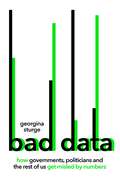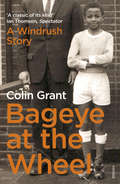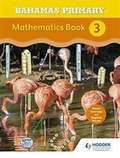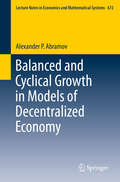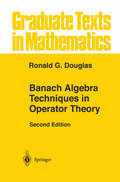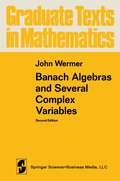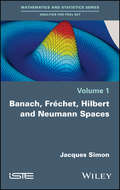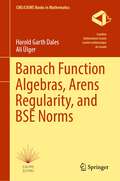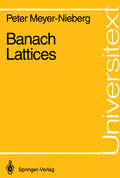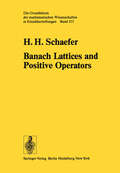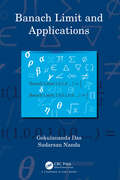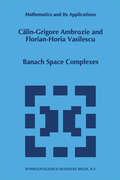- Table View
- List View
Bad Data: How Governments, Politicians and the Rest of Us Get Misled by Numbers
by Georgina Sturge'Essential reading for anyone who's ever wondered where all those numbers come from. Even more essential reading for anyone who hasn't. An incisive and urgently needed book' Tim Harford'[An] entertaining introduction to the uses (and misuses) of data ... a penetrating analysis of why statistical literacy matters to our politics and our daily lives' Professor Jonathan Portes Our politicians make vital decisions and declarations every day that rely on official data. But should all statistics be trusted?In BAD DATA, House of Commons Library statistician Georgina Sturge draws back the curtain on how governments of the past and present have been led astray by figures littered with inconsistency, guesswork and uncertainty.Discover how a Hungarian businessman's bright idea caused half a million people to go missing from UK migration statistics. Find out why it's possible for two politicians to disagree over whether poverty has gone up or down, using the same official numbers, and for both to be right at the same time. And hear about how policies like ID cards, super-casinos and stopping ex-convicts from reoffending failed to live up to their promise because they were based on shaky data.With stories that range from the troubling to the empowering to the downright absurd, BAD DATA reveals secrets from the usually closed-off world of policy-making. It also suggests how - once we understand the human story behind the numbers - we can make more informed choices about who to trust, and when.
Badiou and Indifferent Being: A Critical Introduction to Being and Event
by William WatkinThe first critical work to attempt the mammoth undertaking of reading Badiou's Being and Event as part of a sequence has often surprising, occasionally controversial results. Looking back on its publication Badiou declared: “I had inscribed my name in the history of philosophy”. Later he was brave enough to admit that this inscription needed correction. The central elements of Badiou's philosophy only make sense when Being and Event is read through the corrective prism of its sequel, Logics of Worlds, published nearly twenty years later. At the same time as presenting the only complete overview of Badiou's philosophical project, this book is also the first to draw out the central component of Badiou's ontology: indifference. Concentrating on its use across the core elements Being and Event-the void, the multiple, the set and the event-Watkin demonstrates that no account of Badiou's ontology is complete unless it accepts that Badiou's philosophy is primarily a presentation of indifferent being. Badiou and Indifferent Being provides a detailed and lively section by section reading of Badiou's foundational work. It is a seminal source text for all Badiou readers.
Badiou and Indifferent Being: A Critical Introduction to Being and Event
by William WatkinThe first critical work to attempt the mammoth undertaking of reading Badiou's Being and Event as part of a sequence has often surprising, occasionally controversial results. Looking back on its publication Badiou declared: “I had inscribed my name in the history of philosophy”. Later he was brave enough to admit that this inscription needed correction. The central elements of Badiou's philosophy only make sense when Being and Event is read through the corrective prism of its sequel, Logics of Worlds, published nearly twenty years later. At the same time as presenting the only complete overview of Badiou's philosophical project, this book is also the first to draw out the central component of Badiou's ontology: indifference. Concentrating on its use across the core elements Being and Event-the void, the multiple, the set and the event-Watkin demonstrates that no account of Badiou's ontology is complete unless it accepts that Badiou's philosophy is primarily a presentation of indifferent being. Badiou and Indifferent Being provides a detailed and lively section by section reading of Badiou's foundational work. It is a seminal source text for all Badiou readers.
Bageye at the Wheel: A 1970s Childhood in Suburbia
by Colin GrantTo his fellow West Indians who assemble every weekend for the all-night poker game at Mrs Knight's, he is always known as Bageye. There aren't very many black men in Luton in 1972 and most of them gather at Mrs Knight's - Summer Wear, Pioneer, Anxious, Tidy Boots - each has his nickname. Bageye already finds it a struggle to feed his family on his wage from Vauxhall Motors, but now his wife Blossom has set her heart on her sons going to private school and she will not settle for anything less.This is the story of a feckless father seen through the eyes of his ten-year-old son. It’s a wry and gently comedy about unfulfilling day jobs and late night poker games, of illegal mini-cabs and small-scale drug-dealing. And it is also about a family struggling to belong and a vivid tale of growing up in a vanished world of 1970s suburbia.
Bahamas Primary Mathematics Book 1 (PDF)
by Karen MorrisonThe only series for Primary Maths published in association with the Ministry of Education of the Commonwealth of the Bahamas.- Have confidence in complete coverage of the revised syllabus- Rely on up-to-date, comprehensive and accessible materials- Encourages problem solving, critical thinking and mental strategies- Provide essential practice with write-in workbooks- Inspire students with motivational and attractive resources
Bahamas Primary Mathematics Book 3 (PDF)
by Karen MorrisonThe only series for Primary Maths published in association with the Ministry of Education of the Commonwealth of the Bahamas.- Have confidence in complete coverage of the revised syllabus- Rely on up-to-date, comprehensive and accessible materials- Encourages problem solving, critical thinking and mental strategies- Provide essential practice with write-in workbooks- Inspire students with motivational and attractive resources
BAIL 2008 - Boundary and Interior Layers: Proceedings of the International Conference on Boundary and Interior Layers - Computational and Asymptotic Methods, Limerick, July 2008 (Lecture Notes in Computational Science and Engineering #69)
by Alan Hegarty Natalia Kopteva Eugene O'Riordan Martin StynesThese Proceedings contain a selection of the lectures given at the conference BAIL 2008: Boundary and Interior Layers – Computational and Asymptotic Methods, which was held from 28th July to 1st August 2008 at the University of Limerick, Ireland. The ?rst three BAIL conferences (1980, 1982, 1984) were organised by Professor John Miller in Trinity College Dublin, Ireland. The next seven were held in Novosibirsk (1986), Shanghai (1988), Colorado (1992), Beijing (1994), Perth (2002),Toulouse(2004),and Got ¨ tingen(2006).With BAIL 2008the series returned to Ireland. BAIL 2010 is planned for Zaragoza. The BAIL conferences strive to bring together mathematicians and engineers whose research involves layer phenomena,as these two groups often pursue largely independent paths. BAIL 2008, at which both communities were well represented, succeeded in this regard. The lectures given were evenly divided between app- cations and theory, exposing all conference participants to a broad spectrum of research into problems exhibiting solutions with layers. The Proceedings give a good overview of current research into the theory, app- cation and solution (by both numerical and asymptotic methods) of problems that involve boundaryand interior layers. In addition to invited and contributed lectures, the conference included four mini-symposia devoted to stabilized ?nite element methods, asymptotic scaling of wall-bounded ?ows, systems of singularly p- turbed differential equations, and problems with industrial applications (supported by MACSI, the Mathematics Applications Consortium for Science and Industry). These titles exemplify the mix of interests among the participants.
BAIL 2010 - Boundary and Interior Layers, Computational and Asymptotic Methods (Lecture Notes in Computational Science and Engineering #81)
by Carmelo Clavero José Luis Gracia Francisco J. LisbonaThis volume will contain selected papers from the lectures held at the BAIL 2010 Conference, which took place from July 5th to 9th, 2010 in Zaragoza (Spain). The papers present significant advances in the modeling, analysis and construction of efficient numerical methods to solve boundary and interior layers appearing in singular perturbation problems. Special emphasis is put on the mathematical foundations of such methods and their application to physical models. Topics in scientific fields such as fluid dynamics, quantum mechanics, semiconductor modeling, control theory, elasticity, chemical reactor theory, and porous media are examined in detail.
Balanced and Cyclical Growth in Models of Decentralized Economy (Lecture Notes in Economics and Mathematical Systems #672)
by Alexander P. AbramovThis book is devoted to the study of dynamical models of decentralized economic systems. The models considered are based on the Leontief simple dynamic model with various mechanisms for decentralized planning and management. Branches of the economic system are treated as fully independent economic agents that plan their work according to their own purposes. It is shown that the lack of coordination between economic agents leads to a limit cycle for some economic indicators. Conversely, the exchange of information between the economic agents enables a move toward balanced growth. These results are generalized for the model with dynamics of the productive assets and for the model with the final consumption. The analysis also considers a problem of endogenous technological progress in a decentralized economy. The appendix includes a short review of non-negative matrices. The book offers a valuable resource for mathematical economists and graduate students specializing in mathematical economics.
The Ball and Some Hilbert Problems (Lectures in Mathematics. ETH Zürich)
by Rolf-Peter HolzapfelAs an interesting object of arithmetic, algebraic and analytic geometry the complex ball was born in a paper of the French Mathematician E. PICARD in 1883. In recent developments the ball finds great interest again in the framework of SHIMURA varieties but also in the theory of diophantine equations (asymptotic FERMAT Problem, see ch. VI). At first glance the original ideas and the advanced theories seem to be rather disconnected. With these lectures I try to build a bridge from the analytic origins to the actual research on effective problems of arithmetic algebraic geometry. The best motivation is HILBERT'S far-reaching program consisting of 23 prob lems (Paris 1900) " . . . one should succeed in finding and discussing those functions which play the part for any algebraic number field corresponding to that of the exponential function in the field of rational numbers and of the elliptic modular functions in the imaginary quadratic number field". This message can be found in the 12-th problem "Extension of KRONECKER'S Theorem on Abelian Fields to Any Algebraic Realm of Rationality" standing in the middle of HILBERTS'S pro gram. It is dedicated to the construction of number fields by means of special value of transcendental functions of several variables. The close connection with three other HILBERT problems will be explained together with corresponding advanced theories, which are necessary to find special effective solutions, namely: 7. Irrationality and Transcendence of Certain Numbers; 21.
The Ballet of the Planets: A Mathematician's Musings on the Elegance of Planetary Motion
by Donald BensonThe Ballet of the Planets unravels the beautiful mystery of planetary motion, revealing how our understanding of astronomy evolved from Archimedes and Ptolemy to Copernicus, Kepler, and Newton. Mathematician Donald Benson shows that ancient theories of planetary motion were based on the assumptions that the Earth was the center of the universe and the planets moved in a uniform circular motion. Since ancient astronomers noted that occasionally a planet would exhibit retrograde motion--would seem to reverse its direction and move briefly westward--they concluded that the planets moved in epicyclic curves, circles with smaller interior loops, similar to the patterns of a child's Spirograph. With the coming of the Copernican revolution, the retrograde motion was seen to be apparent rather than real, leading to the idea that the planets moved in ellipses. This laid the ground for Newton's great achievement--integrating the concepts of astronomy and mechanics--which revealed not only how the planets moved, but also why. Throughout, Benson focuses on naked-eye astronomy, which makes it easy for the novice to grasp the work of these pioneers of astronomy.
The Ballet of the Planets: A Mathematician's Musings on the Elegance of Planetary Motion
by Donald BensonThe Ballet of the Planets unravels the beautiful mystery of planetary motion, revealing how our understanding of astronomy evolved from Archimedes and Ptolemy to Copernicus, Kepler, and Newton. Mathematician Donald Benson shows that ancient theories of planetary motion were based on the assumptions that the Earth was the center of the universe and the planets moved in a uniform circular motion. Since ancient astronomers noted that occasionally a planet would exhibit retrograde motion--would seem to reverse its direction and move briefly westward--they concluded that the planets moved in epicyclic curves, circles with smaller interior loops, similar to the patterns of a child's Spirograph. With the coming of the Copernican revolution, the retrograde motion was seen to be apparent rather than real, leading to the idea that the planets moved in ellipses. This laid the ground for Newton's great achievement--integrating the concepts of astronomy and mechanics--which revealed not only how the planets moved, but also why. Throughout, Benson focuses on naked-eye astronomy, which makes it easy for the novice to grasp the work of these pioneers of astronomy.
Banach Algebra Techniques in Operator Theory (Graduate Texts in Mathematics #179)
by Ronald G. DouglasA discussion of certain advanced topics in operator theory, providing the necessary background while assuming only standard senior-first year graduate courses in general topology, measure theory, and algebra. Each chapter ends with source notes which suggest additional reading along with comments on who proved what and when, followed by a large number of problems of varying difficulty. This new edition will appeal to a whole new generation of students seeking an introduction to this topic.
Banach Algebras and Several Complex Variables (Graduate Texts in Mathematics #35)
by John WermerDuring the past twenty years many connections have been found between the theory of analytic functions of one or more complex variables and the study of commutative Banach algebras. On the one hand, function theory has been used to answer algebraic questions such as the question of the existence of idempotents in a Banach algebra. On the other hand, concepts arising from the study of Banach algebras such as the maximal ideal space, the Silov boundary, Gleason parts, etc. have led to new questions and to new methods of proof in function theory. Roughly one third of this book isconcerned with developing some of the principal applications of function theory in several complex variables to Banach algebras. We presuppose no knowledge of severalcomplex variables on the part of the reader but develop the necessary material from scratch. The remainder of the book deals with problems of uniform approximation on compact subsets of the space of n complex variables. For n > I no complete theory exists but many important particular problems have been solved. Throughout, our aim has been to make the exposition elementary and self-contained. We have cheerfully sacrificed generality and completeness all along the way in order to make it easier to understand the main ideas.
Banach, Fréchet, Hilbert and Neumann Spaces
by Jacques SimonThis book is the first of a set dedicated to the mathematical tools used in partial differential equations derived from physics. Its focus is on normed or semi-normed vector spaces, including the spaces of Banach, Fréchet and Hilbert, with new developments on Neumann spaces, but also on extractable spaces. The author presents the main properties of these spaces, which are useful for the construction of Lebesgue and Sobolev distributions with real or vector values and for solving partial differential equations. Differential calculus is also extended to semi-normed spaces. Simple methods, semi-norms, sequential properties and others are discussed, making these tools accessible to the greatest number of students – doctoral students, postgraduate students – engineers and researchers without restricting or generalizing the results.
Banach, Fréchet, Hilbert and Neumann Spaces
by Jacques SimonThis book is the first of a set dedicated to the mathematical tools used in partial differential equations derived from physics. Its focus is on normed or semi-normed vector spaces, including the spaces of Banach, Fréchet and Hilbert, with new developments on Neumann spaces, but also on extractable spaces. The author presents the main properties of these spaces, which are useful for the construction of Lebesgue and Sobolev distributions with real or vector values and for solving partial differential equations. Differential calculus is also extended to semi-normed spaces. Simple methods, semi-norms, sequential properties and others are discussed, making these tools accessible to the greatest number of students – doctoral students, postgraduate students – engineers and researchers without restricting or generalizing the results.
Banach Function Algebras, Arens Regularity, and BSE Norms (CMS/CAIMS Books in Mathematics #12)
by Harold Garth Dales Ali ÜlgerThis book is about semisimple Banach algebras with a focus on those that are commutative. After laying out the necessary background material from functional analysis, geometry of Banach spaces and measure theory, we introduce many specific Banach algebras from operator theory, harmonic analysis, and function theory and study their basic properties. Some of the questions dealt with in the book are: Whether the introduced Banach algebras are BSE-algebras, whether they have BSE norms, whether they have the separating ball property or some variant of it, and whether they are Arens regular. The book contains quite a few new results, as well as new proofs of a good many known results.The book is intended for those who are preparing to work in Banach algebras or who have been doing research in related areas.
Banach Lattices and Positive Operators (Grundlehren der mathematischen Wissenschaften #215)
by H.H. SchaeferBanach Limit and Applications
by Gokulananda Das Sudarsan NandaBanach Limits and Applications provides all the results in the area of Banach limit, its extensions, generalizations and applications to various fields in one go (as far as possible). All the results in this field, after Banach introduced this concept in the year 1932 , are scattered till now. Sublinear functionals generating and dominating Banach Limit, unique Branch Limit (almost convergence), invariant means and invariant limits, absolute and strong almost convergence, applications to ergodicity, law of large number, Fourier series, uniform distribution of sequences, uniform density, core theorems, functional Banach limits are discussed in this book. Discovery of functional analysis such as Hahn-Banach theorem, Banach-Steinhaus Theorem helped the researchers to develop a modern, rich and unified theory of sequence spaces by enveloping classical summability theory via matrix transformation and the topics related to sequence spaces arose from the concept of Banach limit are presented in this book. The unique features of this book are as follows: It contains all the results in this area at one place which are scattered till now. The book is first of its kinds in the sense that there is no other competitive book . The contents of this monograph did not appear in any book form before. The audience of this book are the researchers in this area, the Ph.D. and advanced Masters students. The book is suitable for one or two semester course work for Ph. D. students, M.S. Students of North America and Europe, M. Phil and Masters Students of India.
Banach Limit and Applications
by Gokulananda Das Sudarsan NandaBanach Limits and Applications provides all the results in the area of Banach limit, its extensions, generalizations and applications to various fields in one go (as far as possible). All the results in this field, after Banach introduced this concept in the year 1932 , are scattered till now. Sublinear functionals generating and dominating Banach Limit, unique Branch Limit (almost convergence), invariant means and invariant limits, absolute and strong almost convergence, applications to ergodicity, law of large number, Fourier series, uniform distribution of sequences, uniform density, core theorems, functional Banach limits are discussed in this book. Discovery of functional analysis such as Hahn-Banach theorem, Banach-Steinhaus Theorem helped the researchers to develop a modern, rich and unified theory of sequence spaces by enveloping classical summability theory via matrix transformation and the topics related to sequence spaces arose from the concept of Banach limit are presented in this book. The unique features of this book are as follows: It contains all the results in this area at one place which are scattered till now. The book is first of its kinds in the sense that there is no other competitive book . The contents of this monograph did not appear in any book form before. The audience of this book are the researchers in this area, the Ph.D. and advanced Masters students. The book is suitable for one or two semester course work for Ph. D. students, M.S. Students of North America and Europe, M. Phil and Masters Students of India.
Banach Space Complexes (Mathematics and Its Applications #334)
by C.-G. Ambrozie Florian-Horia VasilescuThe aim of this work is to initiate a systematic study of those properties of Banach space complexes that are stable under certain perturbations. A Banach space complex is essentially an object of the form 1 op-l oP +1 ... --+ XP- --+ XP --+ XP --+ ... , where p runs a finite or infiniteinterval ofintegers, XP are Banach spaces, and oP : Xp ..... Xp+1 are continuous linear operators such that OPOp-1 = 0 for all indices p. In particular, every continuous linear operator S : X ..... Y, where X, Yare Banach spaces, may be regarded as a complex: O ..... X ~ Y ..... O. The already existing Fredholm theory for linear operators suggested the possibility to extend its concepts and methods to the study of Banach space complexes. The basic stability properties valid for (semi-) Fredholm operators have their counterparts in the more general context of Banach space complexes. We have in mind especially the stability of the index (i.e., the extended Euler characteristic) under small or compact perturbations, but other related stability results can also be successfully extended. Banach (or Hilbert) space complexes have penetrated the functional analysis from at least two apparently disjoint directions. A first direction is related to the multivariable spectral theory in the sense of J. L.
